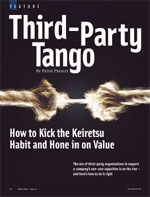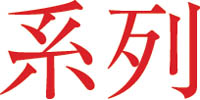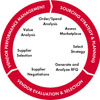|
 THE CLOCK STRUCK 9:30 A.M. It was time for another project huddle -- except this time the huddle involved approximately 300 people, 85 of whom were consultants. I was unsure what disturbed me more -- the consulting firm's judgment to bring such a large number of people together, or the client's failure to understand that this working environment was not going to be productive. THE CLOCK STRUCK 9:30 A.M. It was time for another project huddle -- except this time the huddle involved approximately 300 people, 85 of whom were consultants. I was unsure what disturbed me more -- the consulting firm's judgment to bring such a large number of people together, or the client's failure to understand that this working environment was not going to be productive.
Average consultant billing rates of JPY25,000 per hour would be multiplied by 85 consultants for three hours. This would run approximately JPY6 million for a three-hour project meeting -- not to mention the client's time and cost. The main reason why such an instance occurred was primarily because the buyer did not have a handle on how to use or manage the supplier and passed project control to the consulting firm.
Furthermore, the client could have done so much more to prevent project costs and quality from spiralling out of control. For example, the client project leadership could have been more proactive at managing the supplier, helping to educate the key buyers about the consulting market and how to use consultants. And by interviewing all resources that rolled onto the project, the client could have established whether their skills were suited to the required task.
 For many manufacturers, supply expenditures are reaching unprecedented levels. In some cases, these expenses can total 75 percent of total revenues. Suppliers have a tremendous ability to affect a company's overall financial performance. For many manufacturers, supply expenditures are reaching unprecedented levels. In some cases, these expenses can total 75 percent of total revenues. Suppliers have a tremendous ability to affect a company's overall financial performance.
Why is sourcing becoming such a highly desirable competency for businesses in Japan? The challenge for many is managing these supplier transactions and relationships in an integrated and highly measurable way that helps realize unprecedented business value.
Suppliers come in many different shapes and forms. There are direct material providers, like the food ingredient suppliers that support Nestle Japan, the suppliers that provide auto parts to Toyota or the chemical manufacturers that support the development of beauty products for the Shiseidos of the world. Indirect material and service providers include companies that supply computers, software, warehouses, hardware, housing, facilities, outsourcing and distribution services, to name a few. These are goods or services that are not definitively part of a finished product.
Most supplier transactions in today's business world do not take place under one happy organizational umbrella. Various people will be responsible for the purchase of different goods and services, people who are often not part of the same function and do not communicate with one another on a regular basis. Moreover, inconsistent sourcing processes and tools and disparate data often make it very difficult for an organization to thoroughly understand how sourcing contributes to business value.
 The relationship web The relationship web
The keiretsu system (wherein large Japanese companies own a percentage of their top suppliers) has been used for many years in Japan. Companies often have deeply rooted relationships with their suppliers, making for tough terrain for any outsider attempting to navigate the local decision-making environment.
Often this intricate supply relationship overlooks important sourcing considerations -- such as conducting detailed assessments of different supply markets, evaluating a supplier's track record and understanding whether a supplier is a good long-term fit for the organization. These concerns are bypassed because of the relationship with the mother company.
Historically, supply relationships in Japan have been personalized to the point that buying decisions become dangerously automatic and unexamined. As one Japanese buyer says: "My job is to procure distribution services from Nittsu, which is what I have done for the last six years. I have good relationships with these people and my boss seems very happy."
 When I ask the buyer if he tracks the business value of Nittsu or whether rigid contracts and performance measurements support the relationship, he replies: "We do not have the need to measure the exact business value as we have a contract with the vendor and our relationship is built on trust."
When I ask the buyer if he tracks the business value of Nittsu or whether rigid contracts and performance measurements support the relationship, he replies: "We do not have the need to measure the exact business value as we have a contract with the vendor and our relationship is built on trust."
Another company source reveals that distribution services within the company had not been through an RFP (Request for Proposal) process for three years. The contract had rarely been updated, and more importantly, service levels had decreased for the last two years to the detriment of the business.
There are distinct phases in the sourcing life-cycle: strategy and planning, the supplier evaluation and selection process, and ongoing vendor performance management.
 Strategy & planning Strategy & planning
The catalyst for starting any type of procurement transaction should normally reside within the business. Supply requirements must be driven by a common sourcing strategy that is defined at the senior management level and is then broken down into a specific category or material grouping strategies.
 Of course, third parties will always try to push a supply need into a business through various means (business meetings, luncheons, cold calls and/or networking). This kind of "dating" is fine so long as the business takes the responsibility internally for the planning and defining of what it truly needs from the external marketplace. Of course, third parties will always try to push a supply need into a business through various means (business meetings, luncheons, cold calls and/or networking). This kind of "dating" is fine so long as the business takes the responsibility internally for the planning and defining of what it truly needs from the external marketplace.
Fergus O'Hare from Nike Japan regularly interacts with a variety of Japanese suppliers. "The most important factor in dealing with suppliers is that a business needs to know exactly what it wants from the supplier, supported by laser-focused business requirements," O'Hare says. "Missing a clear articulation of requirements can only result in the client-supplier relationship starting off on the wrong foot. Both client and supplier have equal responsibility for aligning ideas, scope, and overall expectations for different sourcing arrangements. If not, the relationship will be inefficient."
When business needs are clearly articulated (often in an RFP document), expectations can be established at an earlier stage. Suppliers can trust that they are dealing with a prospective client who understands not only their business problem, but how it should be supported by a third party provider -- which can become a leverage point later in the sourcing transaction. On the contrary, a lack of clearly defined supply requirements can often result in the supplier having the upper hand during negotiations.
 Vendor evaluation & selection Vendor evaluation & selection
Carrying out a comprehensive supplier evaluation and selection process is a must for supporting supply requirements. Even if your business does not have a definitive intention of entering a new sourcing arrangement, it is always a shrewd practice to evaluate your current supplier's price and performance against peers via a supply market assessment at certain intervals of the business-supplier relationship.
A recent experience with a global retailer based in Japan reveals some of the nuances that exist today when it comes to sourcing.
Together, the retailer and I conducted a sourcing transaction to select a new POS (Point of Sale) solution with the hope of enhancing functionality that would provide the foundation for a stronger customer loyalty-points program. We undertook a rigorous process of defining business requirements, outlined an extensive vendor evaluation process with clearly defined decision-making criteria (e.g. cost, industry expertise, references, contract flexibility) together with scripts to support system demonstrations. We also engaged in a number of vendor references to assess the reasons why other retailers selected their POS solutions.
 The majority of retailers who participated in the reference checks indicated that they did not conduct a formal business requirements definition or a POS selection process. Without clearly defined business requirements, it became obvious in every case that the buyer was not well-versed in the technology being procured. The majority of retailers who participated in the reference checks indicated that they did not conduct a formal business requirements definition or a POS selection process. Without clearly defined business requirements, it became obvious in every case that the buyer was not well-versed in the technology being procured.
Lack of understanding of what is being procured in turn limits the ability of such retailers to truly understand the value such a solution can provide to the business. Many of the retailer references cited personal or previous working relationships (such as previous employment with the vendor) as the main selection criterion.
With POS solutions costing in excess of JPY400 million to JPY600 million over several years for an average 30- to 40-store retail operation, less savvy buyers can very quickly find themselves in deep water. Costs can significantly increase, and POS providers can and often will push more customizations into the system that often will not add real long-term value to the business. More importantly, a sourcing decision based on a relationship rather than a sound business rationale can severely constrain a business operation down the line.
The higher the value of the sourcing transaction, the greater the need for the buyer to involve persons from different functional areas. If there are no other persons involved, it is at the very least wise to question the buyer's subjectivity, experience and motives.
 In parallel with reference checks, a favorite tactic in trying to identify true supplier capabilities is to go through extensive interviews with proposed team members who would support the defined sourcing requirement -- i.e., the supplier resources you will be working with. Many buyers do not go through extensive reference checks, and this can result in increased long-term frustration. In parallel with reference checks, a favorite tactic in trying to identify true supplier capabilities is to go through extensive interviews with proposed team members who would support the defined sourcing requirement -- i.e., the supplier resources you will be working with. Many buyers do not go through extensive reference checks, and this can result in increased long-term frustration.
Colorful vendor presentations can be impressive, but they aren't always indicative of what you will get in the end. The challenge for buyers is to determine real experiences from those that have been embellished. (Having worked on both the supplier and buyer sides of the fence, I can say that both parties are guilty of questionable work practices.)
A good Japanese friend recently told me about his first project experience with an outsourcing provider. The project was a large SAP (enterprise-wide integrated software) assignment. He was introduced by his new manager to the client as follows: "Taka has a number of years of SAP implementation experience."
To lower expectations, Taka pulled the manager aside later and made sure the manager knew he had absolutely no experience with SAP, had never seen it and did not even know what the SAP abbreviation stood for. The manager responded by saying: "I understand your point. But to clarify, I said you had a number of years of experience. And the number is zero." Taka was assigned to the project three weeks later, with two weeks of SAP training under his belt together with his two years of business experience -- at JPY25,000 yen per hour.
 The above points are especially important now that large outsourcing deals are on the rise here in Japan. With ERP (Enterprise Resource Planning) implementations starting to dry up, many IT companies, outsourcing and consulting firm providers are on the hunt for the next management fad to sell to clients -- which in the US and Europe is large IT outsourcing contracts and new wave technology implementations like RFID (Radio Frequency Identification). The above points are especially important now that large outsourcing deals are on the rise here in Japan. With ERP (Enterprise Resource Planning) implementations starting to dry up, many IT companies, outsourcing and consulting firm providers are on the hunt for the next management fad to sell to clients -- which in the US and Europe is large IT outsourcing contracts and new wave technology implementations like RFID (Radio Frequency Identification).
Many suppliers will portray themselves as being able to serve multiple outsourcing needs (whether it is finance, HR, payroll and/or IT related), which is okay if they have the proven experience. Yet buyers should be cautious of those suppliers who use their 10 best people to sell outsourcing projects as window dressing, with another 50 relatively inexperienced staff in a Trojan horse waiting to be rolled into the new client's environment.
Negotiation and contract definition are all-important elements that must support sourcing transactions. Businesses that do their homework on the supply market in question can often find price savings in the region of 20 percent compared with those buyers who prefer the intuitive approach. Supporting this observation is the need for buyers to project the total cost associated with procuring the goods or services.
 Vendor performance measurement Vendor performance measurement
The language of any contract or service level agreement (SLA) must make sense to the business, and all efforts should be made to ensure that the contract protects its best interests. Suppliers often dislike too many impositions, but being 100 percent comfortable with contractual/SLA documentation is the way forward, instilling accountability at an early stage of the business-supplier relationship.
 Everything that isn't explicitly in the contract/SLA could be subject to a change in the order, which can result in significant unanticipated costs. Matthew Paulus, formerly with Microsoft's operations in Japan and the Asia-Pacific region, has extensive SLA experience. "Closely defining, measuring and managing an SLA with vendors is imperative to understanding their worth," he says. "Basically, if you can't measure it, you can't manage it." Everything that isn't explicitly in the contract/SLA could be subject to a change in the order, which can result in significant unanticipated costs. Matthew Paulus, formerly with Microsoft's operations in Japan and the Asia-Pacific region, has extensive SLA experience. "Closely defining, measuring and managing an SLA with vendors is imperative to understanding their worth," he says. "Basically, if you can't measure it, you can't manage it."
Managing sourcing transactions is critical once they are up and running. Businesses often believe their work is near completion after they have signed on the dotted line. But it has only just begun.
Organizations have to continuously monitor and manage not only the performance of one sourcing transaction, but ideally all transactions in a highly integrated and quantifiable manner. This is one of the main reasons why many Fortune 500 companies like Microsoft are moving toward a centralized sourcing model.
 Global benchmarks Global benchmarks
Likewise, Wal-Mart is extremely effective at fine-tuning its approaches to supplier management on an ongoing basis. Wal-Mart epitomizes sourcing at its best and aggressively funnels realized supply chain savings into other areas of the business -- such as merger and acquisitions, IT, pricing and merchandising -- to ensure its growth in the future.
The much anticipated arrival of Wal-Mart in Japan through its acquisition of Seiyu (see J@pan Inc, July 2002) has many suppliers (Kao Corporation and Johnson & Johnson) and competitors like Daiei, Isetan and Aeon watching warily, with a few even trying to emulate the business model. As ludicrous as it seems, many are going so far as to take reconnaissance trips to the Wal-Mart headquarters in Bentonville, Arkansas, to observe the Wal-Mart shopping experience and gather intelligence.
 In the US and other global markets (Mexico, Canada and the UK), Wal-Mart has demonstrated that efficient and well-integrated processes and the use of Retail Link, its proprietary technology, have been the core of its sourcing successes -- in addition to partnerships with third party sourcing technologists like Atlas Commerce. In the US and other global markets (Mexico, Canada and the UK), Wal-Mart has demonstrated that efficient and well-integrated processes and the use of Retail Link, its proprietary technology, have been the core of its sourcing successes -- in addition to partnerships with third party sourcing technologists like Atlas Commerce.
The fear of many Japanese suppliers is that Wal-Mart's arrival will force rapid technological change in its prospective supply base and competitor's businesses -- which is not always so bad. The Wal-Mart business model will make every constituent that is part of the Japanese retail industry finally understand the grave inefficiencies that exist in this country. Suppliers themselves need to take a hard look at their own sourcing practices to offset the decreasing margins when dealing with a retailer like Wal-Mart -- especially when other retailers start to procure goods and services the Wal-Mart way.
Call it the domino effect, an effect that could cause severe ripples in Japan's retail landscape. Improved retail sourcing practices will not only benefit the Japanese consumer but will likely result in significant consolidation within certain segments of the retail industry.
 Many predict that Wal-Mart's next acquisition in Japan will be a wholesaler. Without doubt, this will provide the catalyst for change not only in the wholesale sector, but also in the retail, consumer manufacturing and distribution sectors. The change will often be subtle, but the undercurrents will be most deeply felt by those who do not understand the power of sourcing within their business or how to unlock business value when interacting with third party providers. Many predict that Wal-Mart's next acquisition in Japan will be a wholesaler. Without doubt, this will provide the catalyst for change not only in the wholesale sector, but also in the retail, consumer manufacturing and distribution sectors. The change will often be subtle, but the undercurrents will be most deeply felt by those who do not understand the power of sourcing within their business or how to unlock business value when interacting with third party providers.
If there were any doubters about Wal-Mart's ability to successfully transplant its sourcing model to Japan, look no further. As of this writing, Seiyu is predicting a return to profit in 2004, helped by efficiencies and higher sales driven by improved sourcing.
Often it takes an industry leader, whether they are Japanese or not, to blow the whistle on industry inefficiencies. Many are recognizing the need to use different skills and business backgrounds from across the world to define business models for the future.
Carlos Ghosn has guided Nissan in recent years to move 65 percent of its manufacturing to the US, and Nissan expects that up to 90 percent of its manufacturing will be US-based in the next five years. At the same time, Nissan has abandoned its old supplier management model by selling its ownership in suppliers and adopting new strategies to collaborate more closely with its US and Canadian suppliers. The company also recently aimed to reduce purchasing costs 20 percent in a three-year plan; it achieved this goal in only two years.
"Nissan and other Japanese companies used the keiretsu system of supplier management, but with the Nissan Revival Plan, our CEO announced to all suppliers at one big gathering that we were no longer going to maintain a keiretsu system," says Emil Hassan, Senior Vice President of North American Manufacturing, Purchasing, Quality and Logistics for Nissan North America, in a recent report.
 The smart businesses are the ones that not only recognize supplier management as a business opportunity, but that are also quick to move aside non-value-adding relationships and embrace the need to standardize sourcing plans, processes, tools and metrics for all sourcing transactions. The smart businesses are the ones that not only recognize supplier management as a business opportunity, but that are also quick to move aside non-value-adding relationships and embrace the need to standardize sourcing plans, processes, tools and metrics for all sourcing transactions.
In an ideal world, all sourcing activities (planning, supplier evaluations, selections, negotiations, contracts and performance management) would be highly automated, allowing the buyer to become focused less on the transaction and more on strategic analyses to make the right decision for the business. Better still would be having all sourcing transactions highly integrated into supplier performance "dashboards," closely linked to key business and financial targets.
O'Hare from Nike Japan believes this is where significant business value can be realized: "Most companies in Japan do not track in a consistent way the supplier transactions and the manner in which goods are procured. There are tremendous saving opportunities in tracking the supplier promises from the start of the business requirements stage, through to contract management and the overall life-cycle of the client-supplier relationship. The challenge is aligning all the right people who have influence over procuring different goods and services."
Organizations that can effectively segment value-adding suppliers should use such information to determine future business collaborations -- such as the platform for co-product development with suppliers, new business models, value-based joint ventures and strategic partnerships. Time and again I hear of such advanced collaboration models under-performing or even failing in Japan. Largely, this can be attributed to poor sourcing practices.
Conservative estimates of the costs of implementing a tightly integrated supplier management program equate to cost and efficiency savings in the region of 15 to 20 percent of total supplier expenditures for most Japanese businesses -- not pocket change for companies that have revenues of $500 million per annum and spend 50 percent of their revenues on external providers. Yet capturing these benefits may require acknowledging the Japanese "step by step" approach to change. Yet waiting too long and executing too slowly will only give the competition the upper hand.
@
|